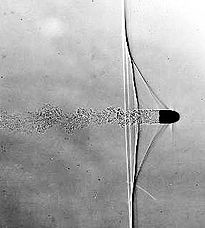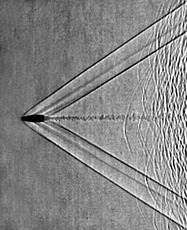Shadowgraph
Shadowgraph is an optical method that reveals non-uniformities in
In principle, a difference in temperature, a different gas, or a
Sunlight shadowgraph
Some aquatic predators detect their transparent prey by way of their shadows cast upon the ocean floor. It was Robert Hooke[1] who first scientifically demonstrated the sunlight shadowgraph and Jean-Paul Marat[2] who first used it to study fire. A modern account of shadowgraphy is given by Gary S. Settles.[3]
Applications
Applications of shadowgraphy in science and technology are very broad. It is used in
Shadowgram (Shadowgraph)
According to
Cartoons
The shadowgraph and shadowgram have been used in animation, where they reinforce the cartoon's realism. One first use was made by
Postcards
Additionally the term Shadowgraph was used by English postcard publishers E.T.W. Dennis & Sons Ltd. of London and Scarborough for a series of 'Hold up to the Light' postcards in the 1950s. In these a saucy image can be seen through what seems an innocent picture when a light is shone through the card.[6]
Gallery
|
|
See also
- Laser schlieren deflectometry
- Mach–Zehnder interferometer
- Optical comparator
- Schlieren
- Schlieren photography
References
- ^ Hooke, R., "Of a New Property in the Air," Micrographia, Observation LVIII,217-219, London(1665).
- ^ Marat, J.-P., Recherches physiques sur le feu, Paris, France:Cl. Ant. Jombert, 1780.
- ^ Settles, G. S., Schlieren and shadowgraph techniques: Visualizing phenomena in transparent media, Berlin:Springer-Verlag, 2001.
- ^ Weinberg, F.J., Optics of flames: including methods for the study of refractive index fields in combustion and aerodynamics, London:Butterworths, 1963.
- ISBN 88-86155-27-1p 46
- ^ "MetroPostcard Publishers D". Metropolitan Postcard Club of New York City. Archived from the original on 2008-09-15. Retrieved 2008-10-02.




